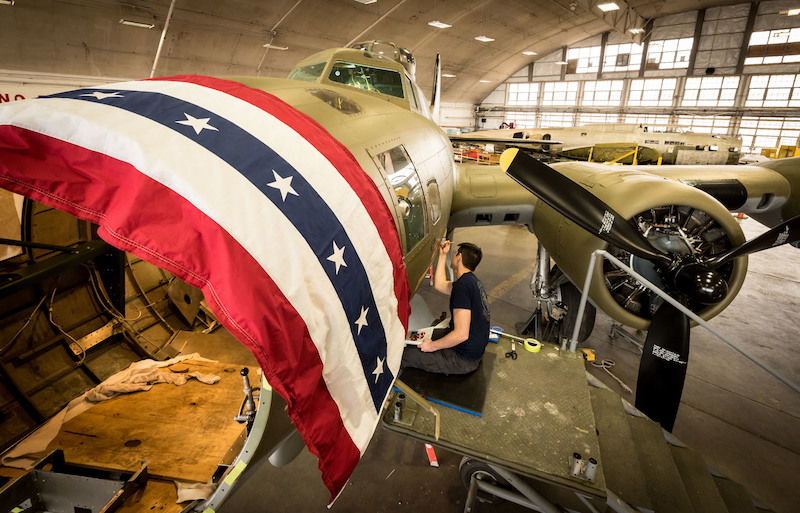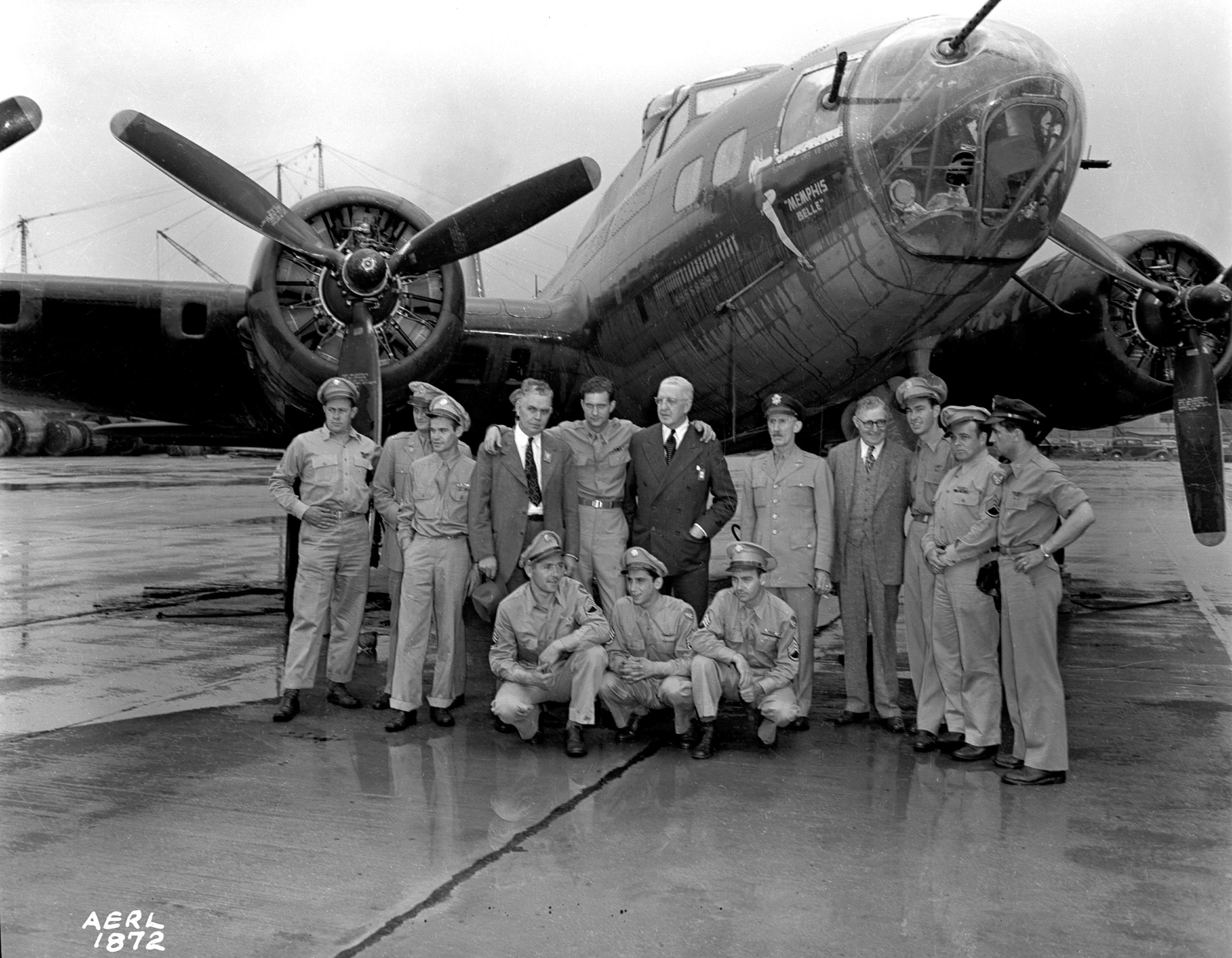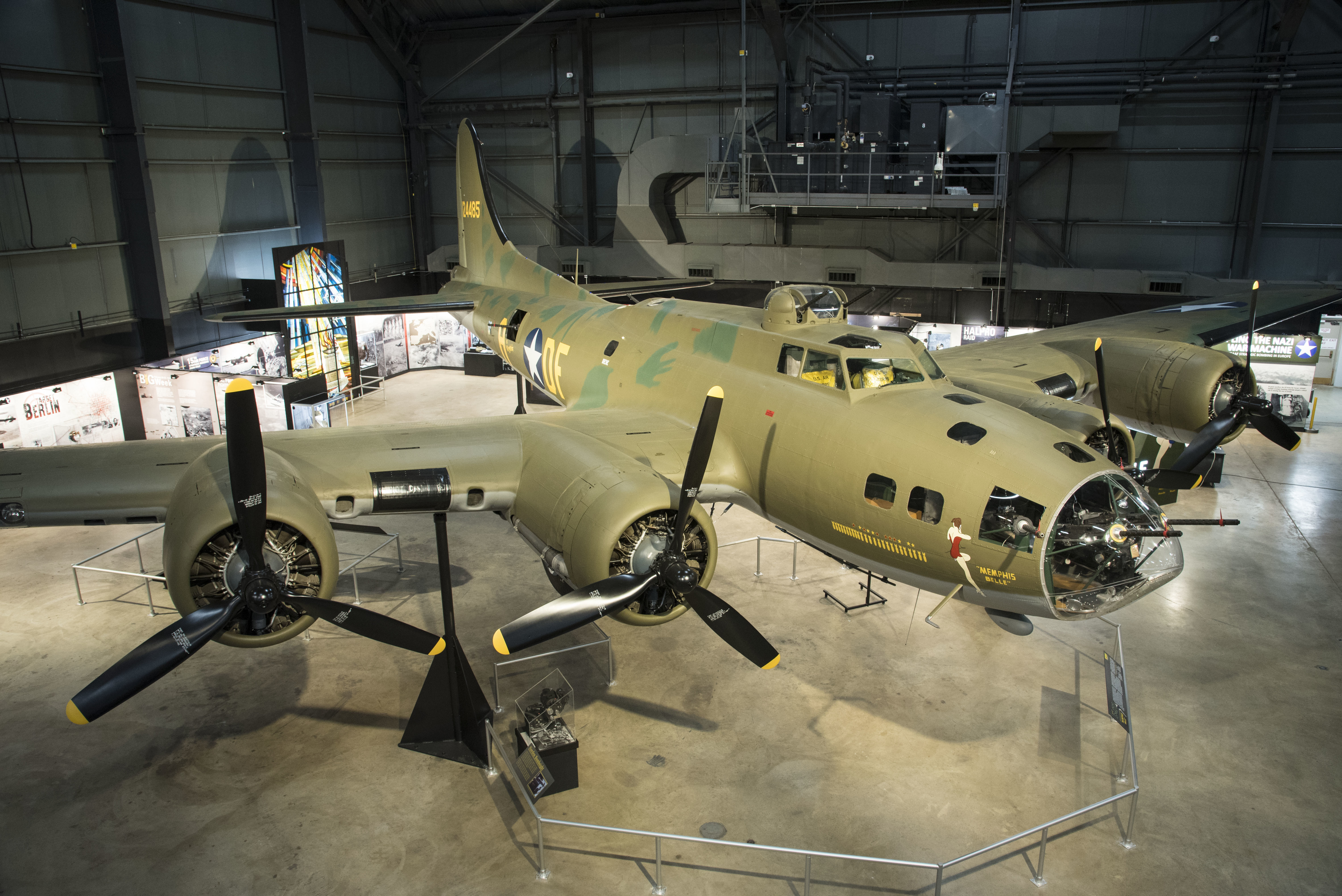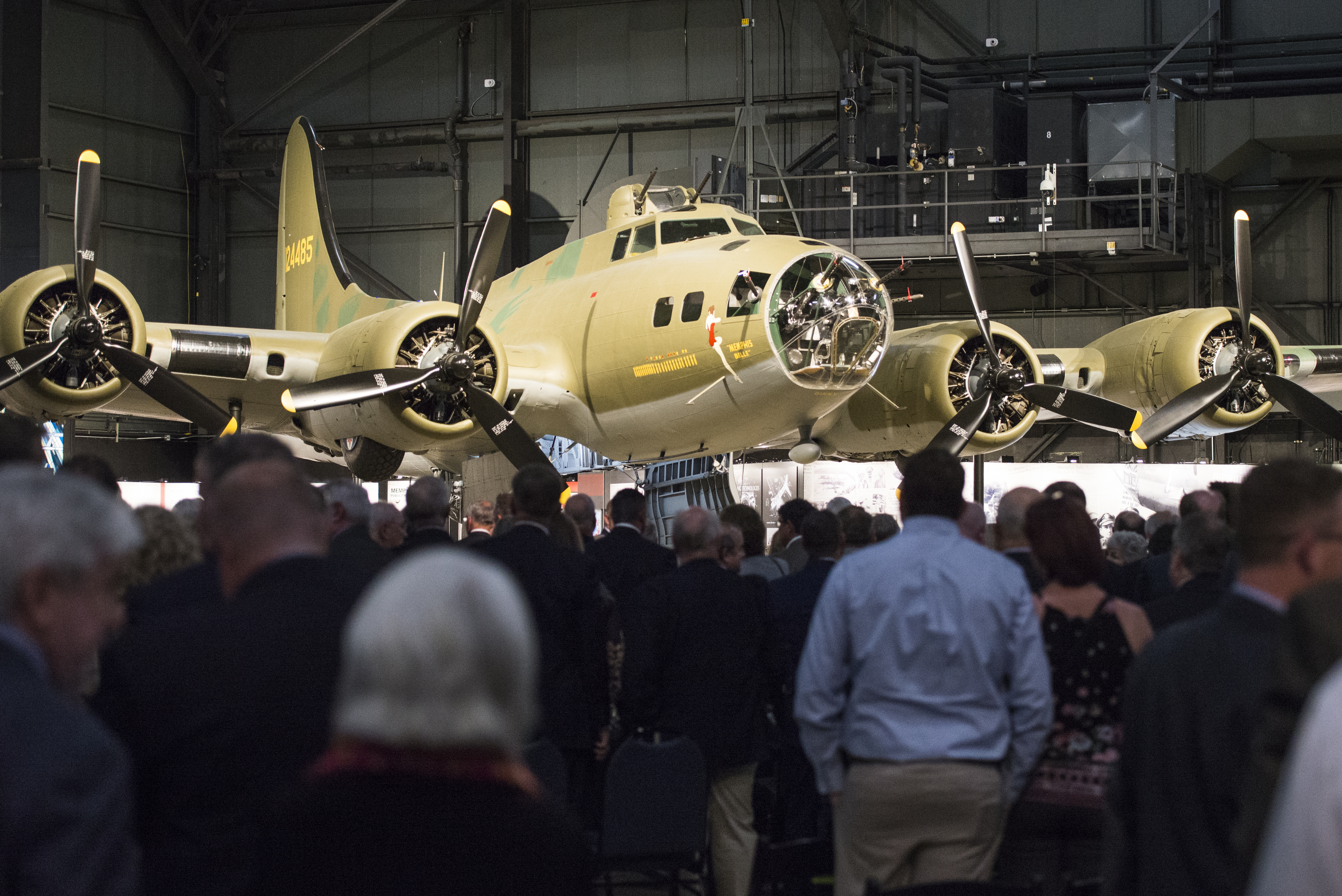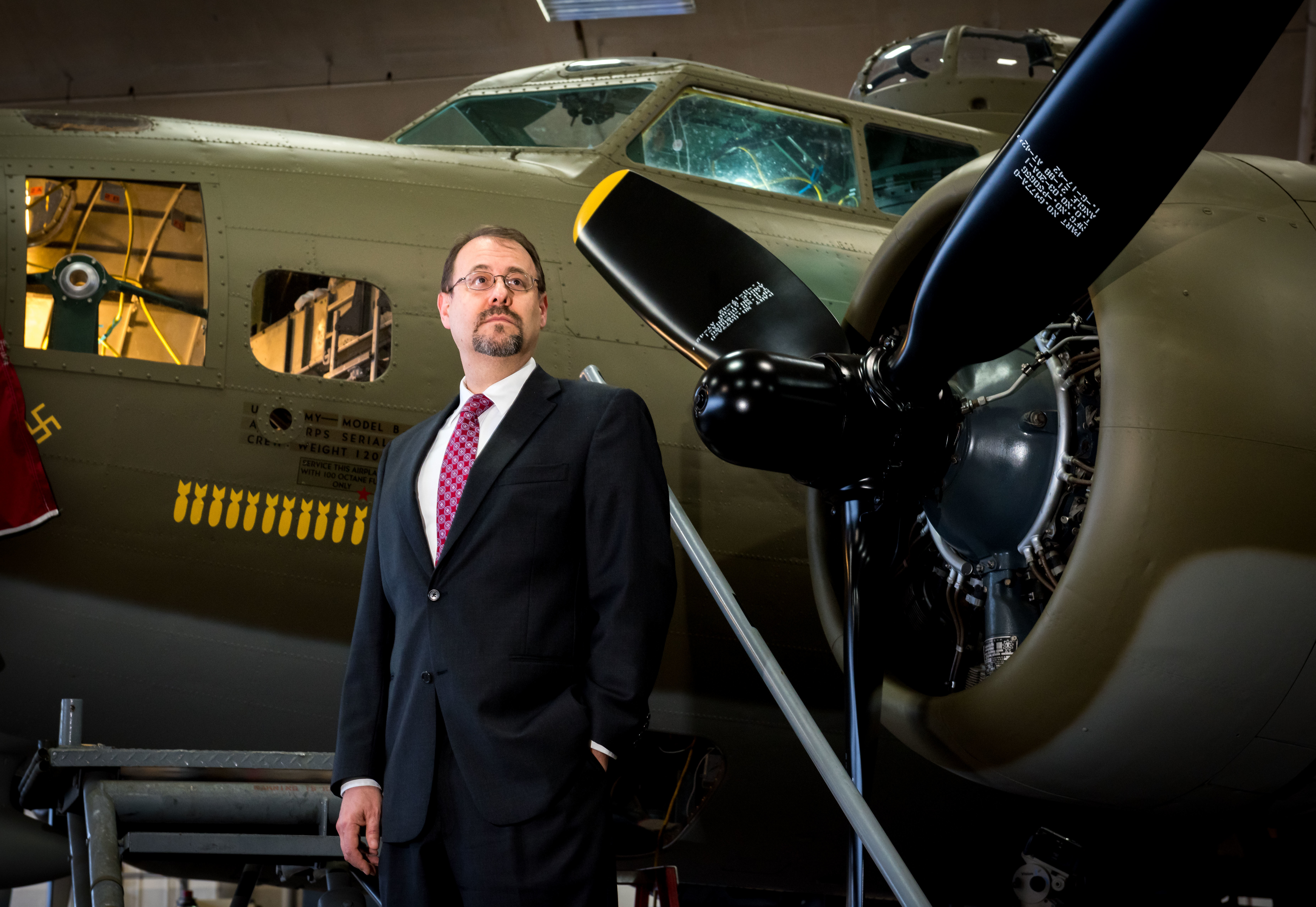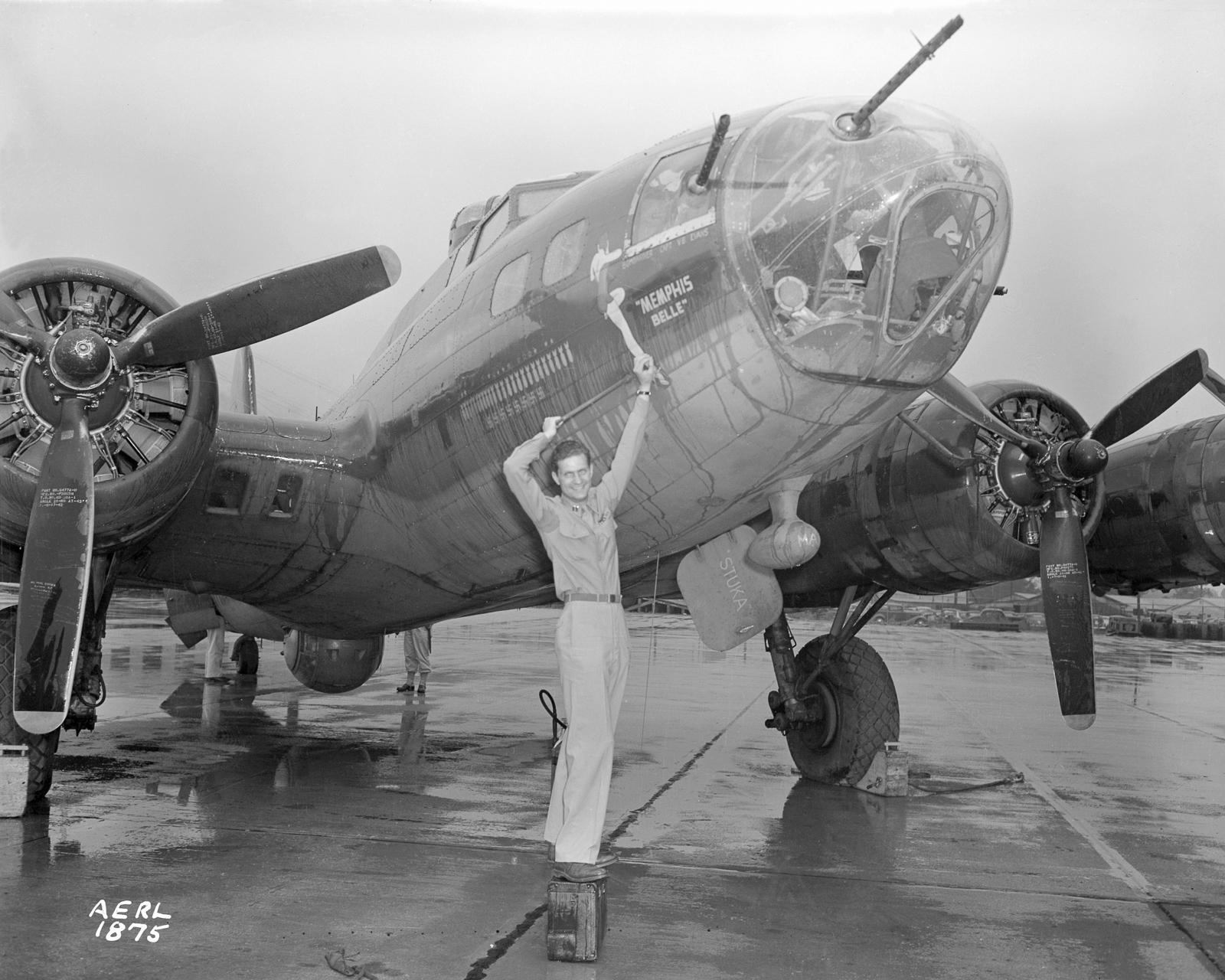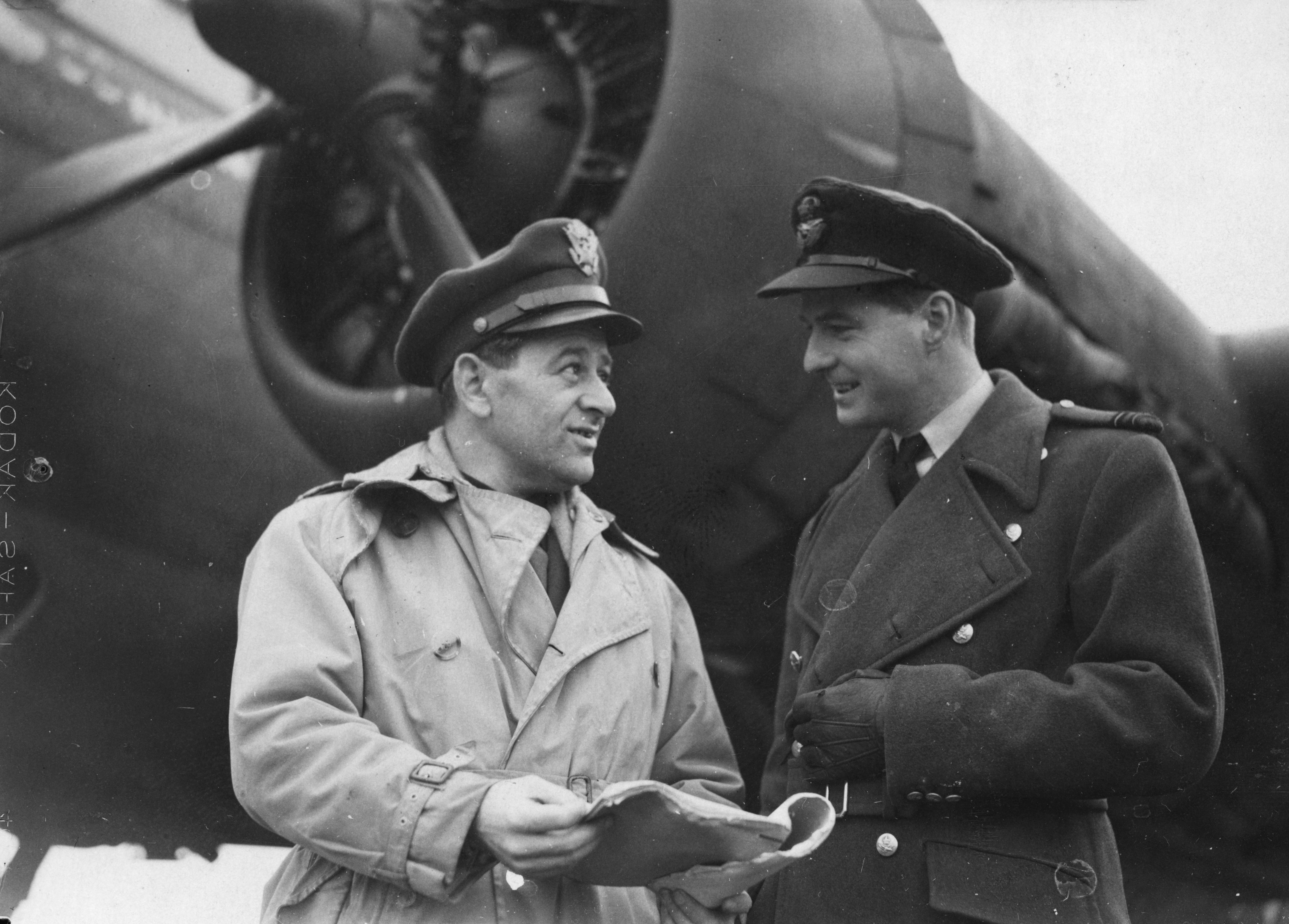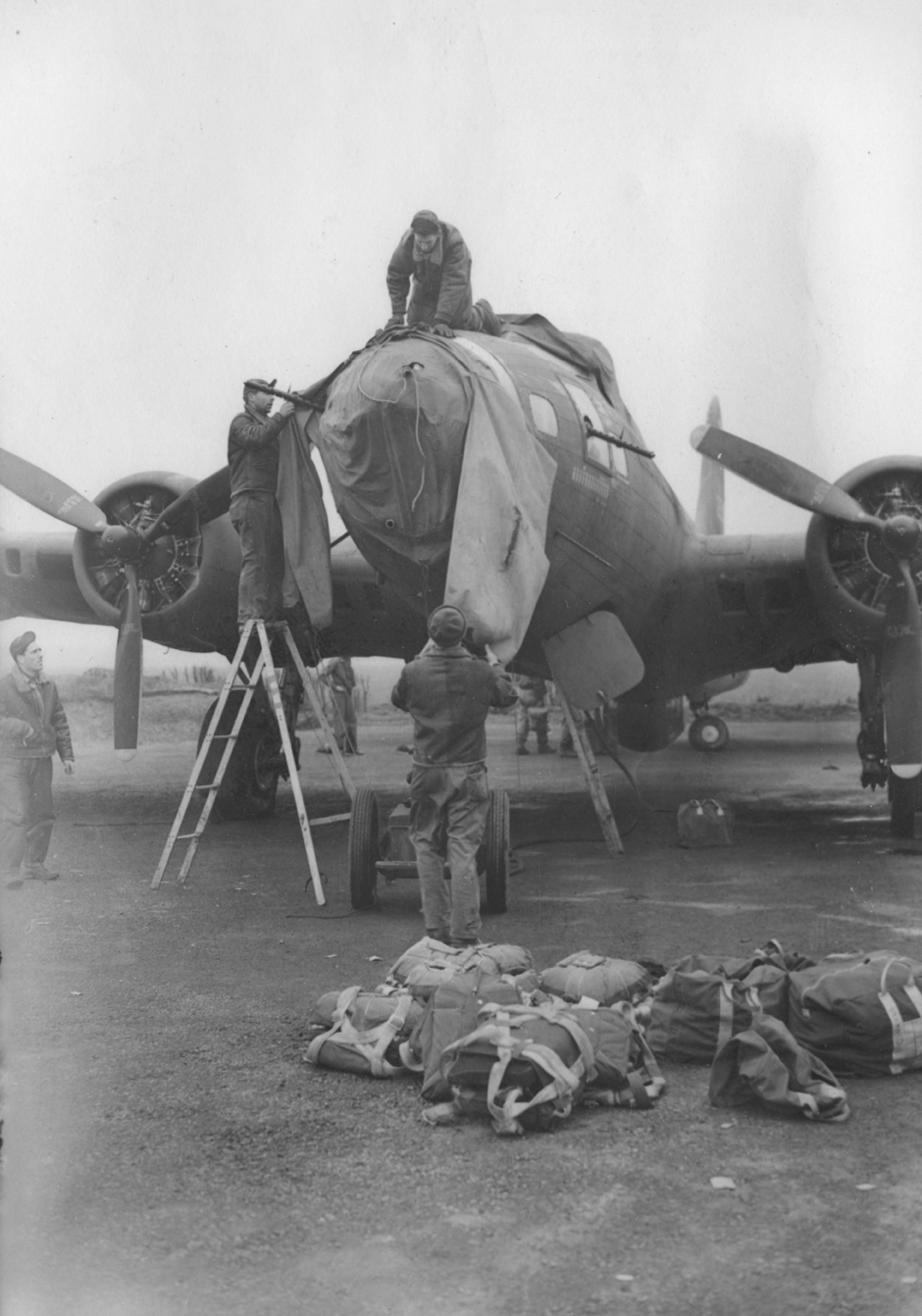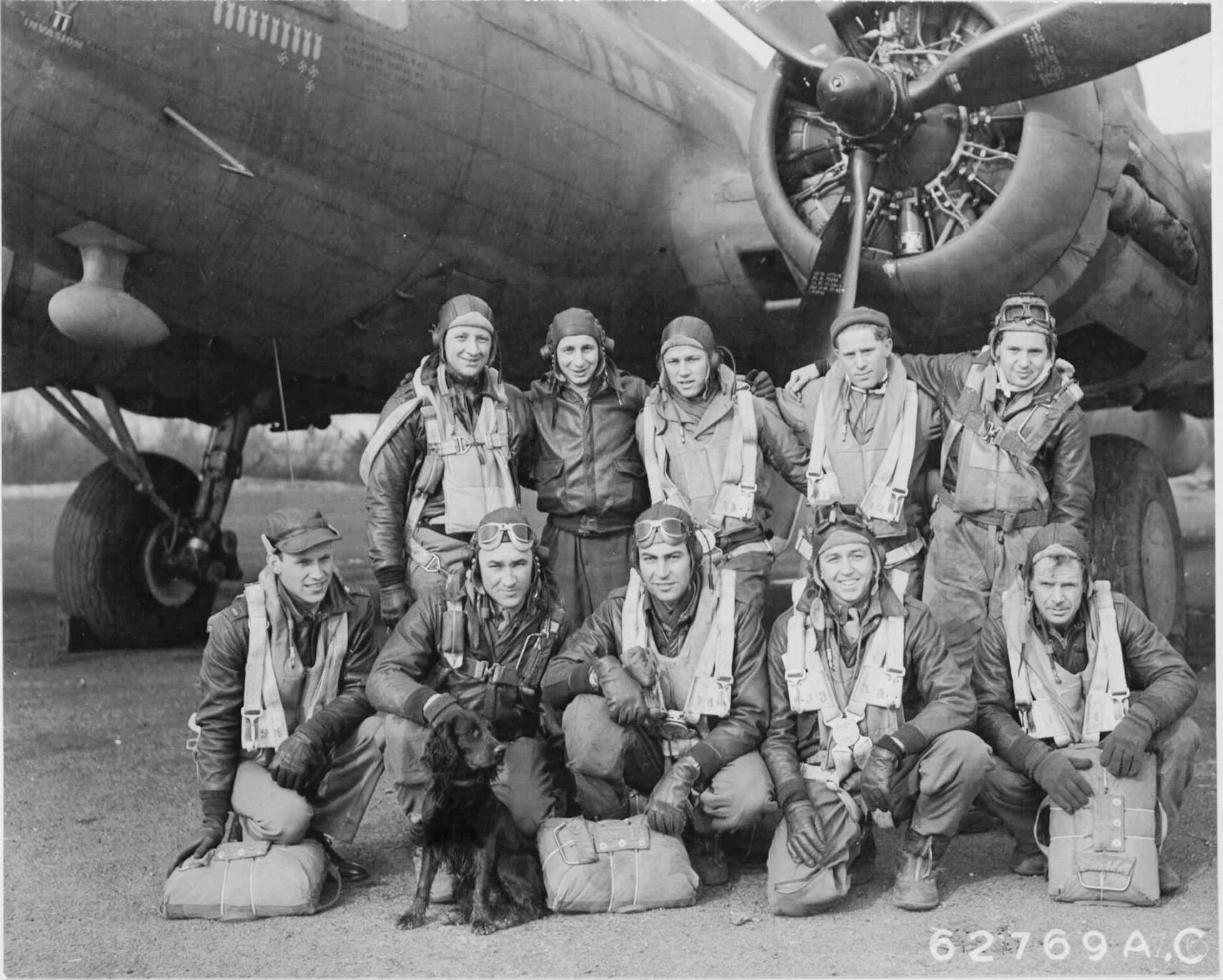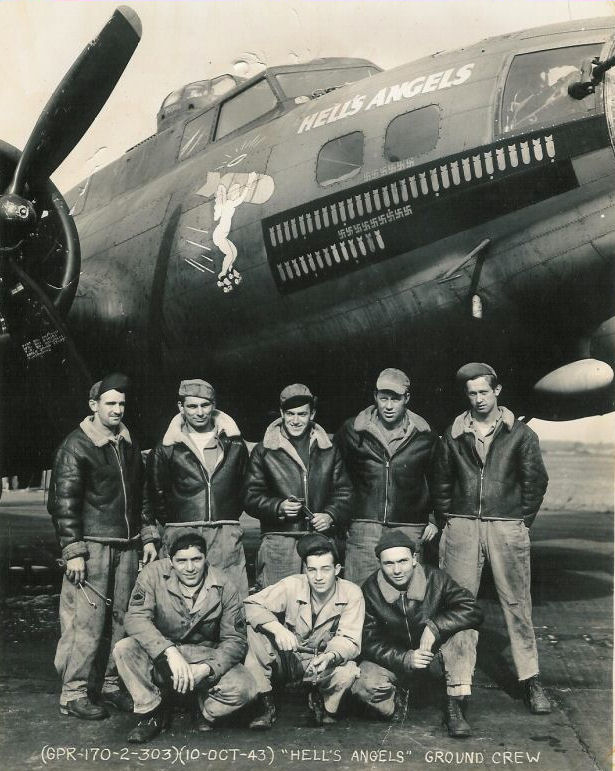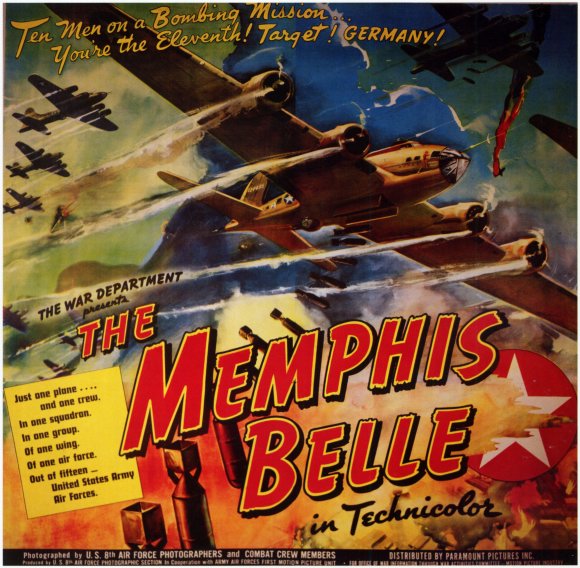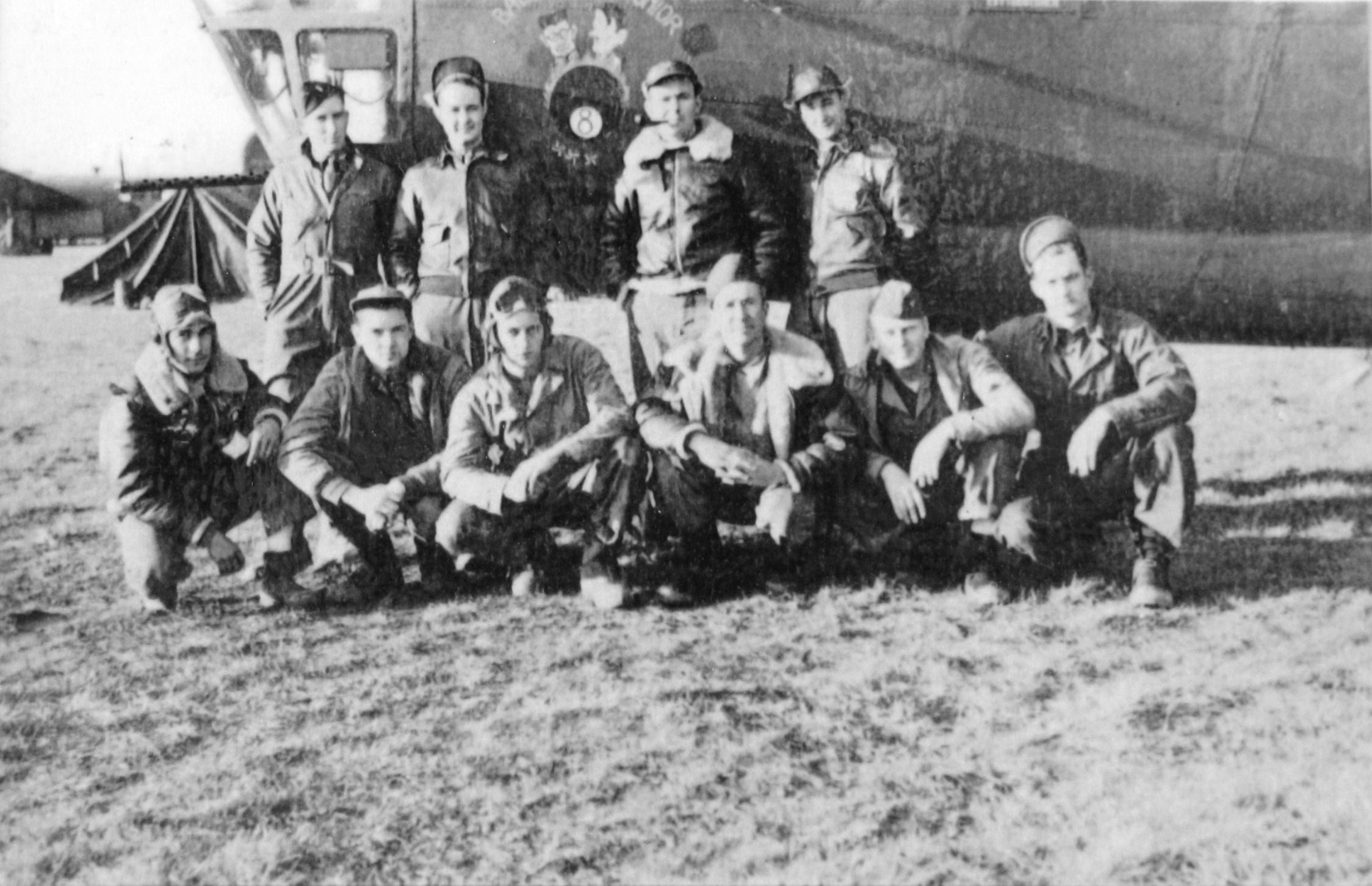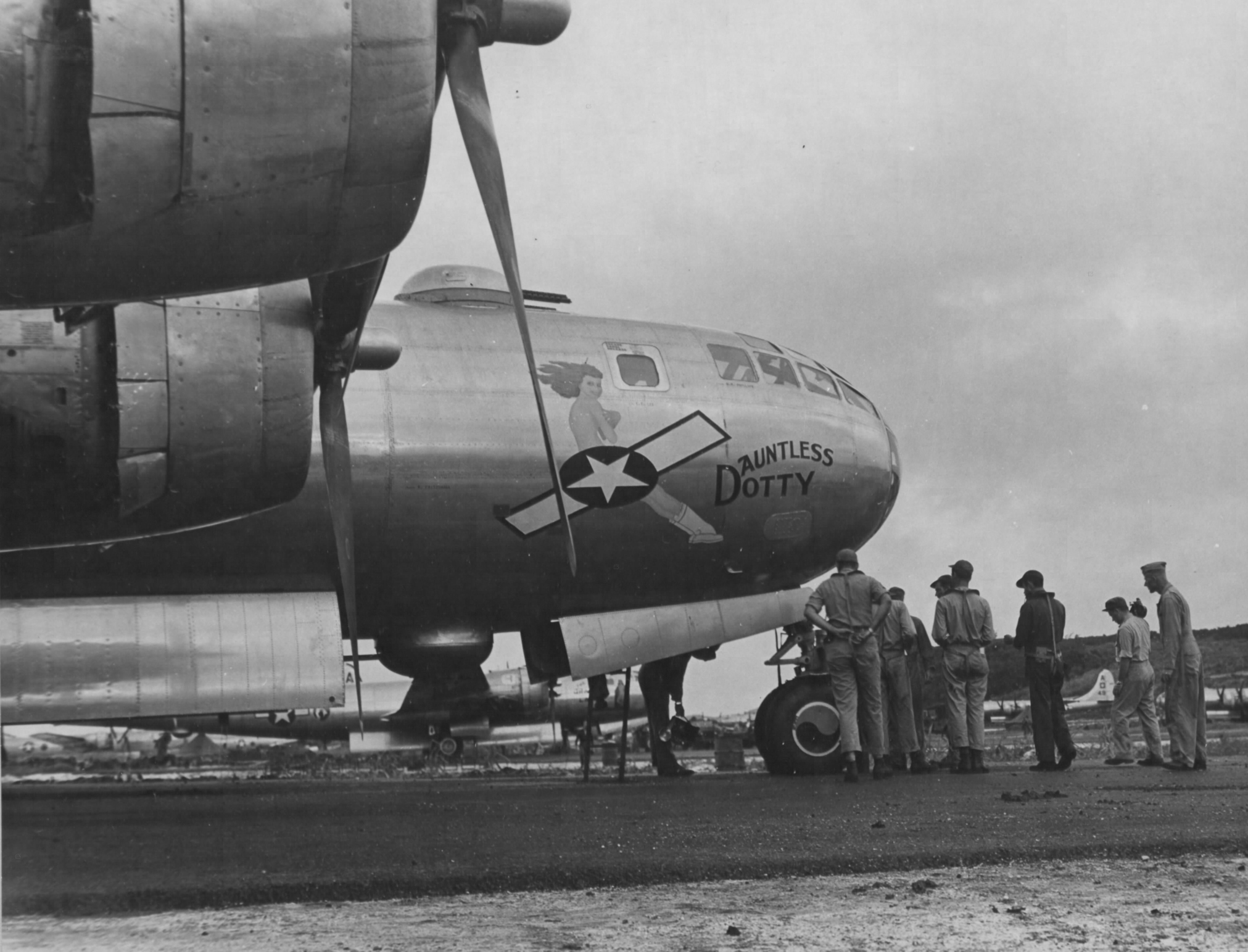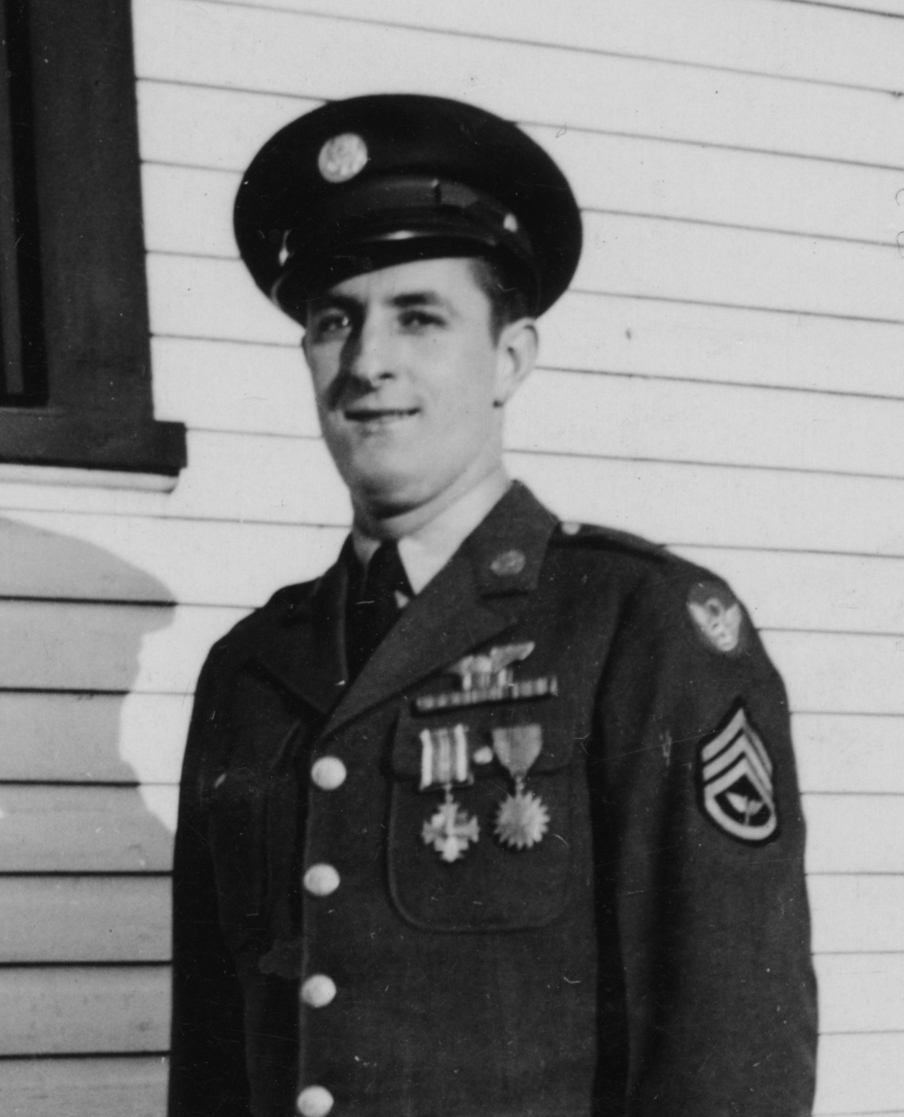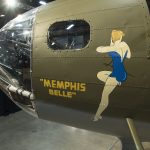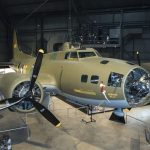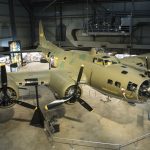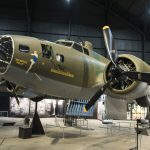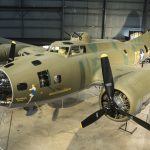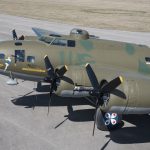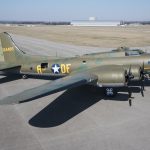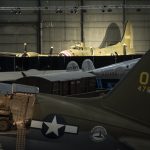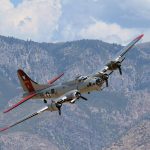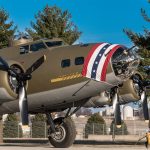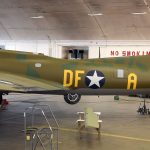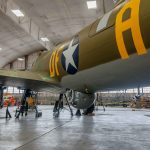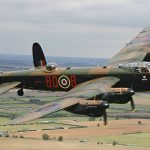With the unveiling last month of the B-17F Flying Fortress Memphis Belle at the National Museum of the U.S.Air Force, Airman Magazine published a fascinating article on the B-17, her crew, along with some fascinating insight into the methods behind the detailed restoration. There was also the mention of one of the Belle’s crewmen, waist gunner SSgt. E.S.Miller, who wasn’t able to make the triumphant return to the USA in 1943 to take part in the Memphis Belle’s War Bonds Tour. The new exhibit at the Air Force Museum shines a light on his service for the first time. We thought our readers would be interested in this piece, although we have added a lot of images to supplement its telling…
Through the cockpit windscreen, Capt. Robert Morgan saw flashes of light from the wings and engine cowling of a German Focke-Wulf Fw 190 at his 12 o’clock and closing at an incredible rate. Each wink of light from the fighter’s wing root meant another 20mm cannon shell was heading directly at his B-17F Flying Fortress at over 2,300 feet per second.
Having no room to dive in the crowded formation of B-17 bombers of the 91st Bomb Group, he pitched up. The Luftwaffe fighter’s shells impacted the tail of the aircraft instead of coming straight through the windscreen.
Over the intercom Morgan heard his tail gunner, Sgt. John Quinlan, yelling that the aircraft’s tail was shot to pieces and what was left was in flames.
It was January 23, 1943. Morgan and his nine crewmen aboard the Memphis Belle had just fought their way through a swarm of Luftwaffe fighters, dropped their bombs on a Nazi submarine base in the coastal city of Lorient in occupied France and were fighting to survive the return trip to the Eighth Air Force base in Bassingbourn, England. Morgan began calculating if the crew should bail out and become prisoners of war before the tail tore completely off the bomber trapping the crew in a death spiral culminating in a fiery crash.
A moment later, Quinlan reported that the fire in the tail had gone out. The Memphis Belle and her crew would survive the mission; the crew’s eighth and the bomber’s ninth.
They would have to survive 17 more missions to complete the required 25 to rotate home. All would be flown during a period of World War II when the Luftwaffe was at the height of its destructive powers.
Against all odds, the Memphis Belle crew flew those missions, their last to once again bomb the U-boat pens at Lorient on May 17, 1943, before returning safely to England for the final time. Bottles of Champagne were uncorked and radio operator Tech. Sgt. Robert J. Hanson collapsed onto the flightline and kissed the ground.
For the “Belle” herself, it was only mission 24 and the plane had to fly once more with an alternate crew on May 19.
The B-17 and its crew would be the first to return alive and intact to the U.S. [Ed. Another aircraft and crew had been slated to do so, a couple of months previously, but sadly that story ended in tragedy. B-24D Liberator Hot Stuff crashed in Iceland on her flight back to the USA, taking the lives of half her original crew, plus several senior officers aboard, one of whom was Gen.Frank Andrews the man then slated to lead the Normandy invasion effort, rather than Gen. Dwight Eisenhower.]
Memphis Belle’s crew were welcomed home as the heroes they were and immediately embarked on a 2½-month, nationwide morale tour to sell war bonds. The tour was also to encourage bomber crews in training that they too could make it home. It made celebrities of both the “Belle” and its crew.
Ironically, the two and a half months of press conferences, parties and glad-handing officers and politicians was about the same amount of time during the “Belle’s” combat tour that 80 percent of the 91st Bomb Group’s B-17s and their crews were lost to German fighters and anti-aircraft fire.
“Eighty percent losses means you had breakfast with 10 men and dinner with only two of those 10,” Morgan said in an interview after the war. During the totality of the air war over Europe more than 30,000 U.S. Airmen aboard heavy bombers, like the B-17, would be killed.
Seventy-five years to the day after that 25th mission, the National Museum of the U.S. Air Force honored the bravery of those bomber crews, some of the first Americans to take the fight to the Nazis in WWII, when they unveiled for public display the largely restored B-17F 41-24485 Memphis Belle as part of a three-day celebration, May 17-19, 2018.
According to the museum curator in charge of the Memphis Belle exhibit, Jeff Duford, the weekend included more than 160 WWII re-enactors showcasing their memorabilia, WWII-era music and vehicles, static displays of other B-17s, flyovers of WWII-era aircraft and presentations of rare archival film footage. The Memphis Belle is now the centerpiece of an exhibit documenting the strategic bombing campaign over Europe.
“The ‘Memphis Belle’ is an icon that represents all the heavy bomber crewmen who served and sacrificed in Europe in World War II,” Duford said, “In many ways the Memphis Belle is the icon for the United States Air Force.
“You look at the U.S. Marines, they have this wonderful icon of the flag being raised over Mount Suribachi on Iwo Jima and everyone recognizes that. It symbolizes service and sacrifice and tenacity and teamwork. Well, the Air Force has that symbol too, and it’s this airplane. It demonstrates teamwork. The crews had to work together. The planes in formation had to work together. The formations had to work together with the fighter escorts.”
The service and sacrifice of the young men still leaves Duford awestruck even after working on the “Belle” project for a decade.
“How does one climb inside of this aircraft knowing that they are probably not going to come home? And they don’t do that one time; two times; three times; 10 times – they have to do it 25 times,” said Duford. “Once they got inside the airplane, they had no place to run. There were no foxholes to be dug. The skin on those airplanes is so thin that a bullet or flak fragment would go through it like a tin can because that’s essentially what it was.”
“The odds were that every 18 missions, a heavy bomber was going to be shot down. So when you think the crew had to finish 25 missions to go home, statistically it was nearly impossible. It was one-in-four odds that a heavy bomber recruit would finish their 25 missions. Those other three crew members would’ve been shot down and captured, killed or wounded so badly they couldn’t finish their tour.”
The fact the Memphis Belle crew survived their tour was of great value to the U.S. Army Air Forces in maintaining support for the daylight strategic bombing campaign over Europe, which was still, in fact, an experiment.
“Back then, there was no book on high altitude strategic bombing. The generals didn’t know any more than we did. They had to figure bombing strategy as we went along,” said Morgan in a book he would write after the war, “The Man Who Flew the Memphis Belle”.
The B-17 was named the “Flying Fortress”, because it was bristling with .50 caliber machine guns covering every angle of attack by German fighters, save one. The theory was that all that defensive firepower would be amplified by heavy bombers flying in tight formations, called “boxes”, enabling them to protect each other from attacking fighters.
While the German Messerschmitt and Focke-Wulf fighters sometimes paid a price for attacking the formations, they soon developed tactics that exploited a design weakness in B-17Fs, like the Memphis Belle.
While twin .50 caliber machine guns in top and belly turrets and the tail and single .50 cal. gunners protected the bomber, the 12 o’clock position was covered by a lone .30 caliber machine gun – no match for the German fighters. Because the bomber formations had to fly straight and level to initiate their bombing run, the Luftwaffe fighter pilots began attacking the formations head on. The ensuing carnage was ghastly.
“The secret to the B-17 was the capability of flying in tight formations, so tight that the wings were often almost touching,” wrote Morgan. “We were able to put out an amazing amount of firepower… but, I also positively feel that was a bit of divine intervention for our crew.”
While the addition of Allied fighter escorts helped fend off some German attackers, the fact that the B-17s had to fly at 25,000 feet or lower to maintain any semblance of accuracy on target put them in the range of the deadly German 88mm anti-aircraft gun. No amount of machine guns or friendly fighters could counter the dense flak approaching targets while flying straight and level.
Bomber crews had to just grit their teeth and pray.
“They felt like they were a great crew. They were tightly knit, confident and dedicated to what they were doing,” said Duford. “However, being in those formations, flying straight and level with enemy anti-aircraft and fighter aircraft, there certainly was a little bit of luck for them too.”
Luck, both good and bad, was also a factor in the “Belle” crew, despite not being the first crew to complete 25 missions, being the one to return to the U.S. for a bond and morale tour.
The “Belle’s” selection for the morale tour was the result of a film project about the strategic bombing campaign that was the brainchild of USAAF Gen. Hap Arnold and a Hollywood director, William Wyler, who had volunteered to serve his country in the best way he knew how.
It was hoped that a film documenting a bomber crew as they successfully completed a combat tour would calm new recruits, who were hearing stories of the carnage overseas, and assuage the doubts of the public, press and politicians that strategic bombing was a failure.
Wyler, an immigrant who was born in the Alsace region of modern-day France when it was part of the German Empire prior to World War I and who would go on to win three Best Director Academy Awards, including one for “Ben-Hur”, was commissioned as a major and headed to England with a film crew to document the fight in skies over Europe.
Wyler and his cameraman flew with B-17 combat crews and began filming missions of a B-17F of the 401st Bomb Squadron of the 91st Bomb Group named “Invasion II”. His staff also began interviewing and making publicity photographs of the crewmembers, as they drew closer to completing 25 missions.
However, on April 17, 1943, the reality of war spoiled the Hollywood ending during their 23rd mission to Bremen, Germany. Invasion II crashed after being hit by flak over Borhmen, Germany, setting the cockpit and wing on fire. The crew managed to bail out, but all became prisoners of war.
Wyler regrouped and found a plane and crew with the 324th Bomb Squadron that was also close to completing their combat tour. The Memphis Belle, named for Morgan’s girlfriend, Margaret Polk of Memphis, Tennessee, and its crew took center stage.
While the crew of “Hell’s Angels” completed their tour on May 13, 1943, four days before the “Belle”, there was no film of that plane and crew. Consequently, it was the “Belle” and its crew that would fly mission 26 back to the U.S. and receive a hero’s welcome.
Wyler’s film, “Memphis Belle: A Story of a Flying Fortress”, would be released and distributed by Paramount Pictures the following year.
It was a film that came with a high price tag. One of Wyler’s cinematographers, 1st Lt. Harold J. Tannenbaum, a veteran of World War I, was killed in action during the filming when the bomber he was in was shot down over France on April 16, 1943. [Ed. Tannenbaum was in B-24 41-23983. Some crew members were blown clear of the aircraft when it exploded, and managed to parachute to safety. Apparently, Tannenbaum managed to bail out too, but failed to properly fasten his parachute on and he sadly fell to his death.]
Until the end of the war, the “Belle” was used as a training aircraft, but instead of being torn apart for scrap like most of the other 12,700 B-17s built during the war, the city of Memphis, Tennessee, put the aircraft on display for nearly 50 years.
The historic aircraft came to the National Museum of the U.S. Air Force in October 2005, when work began on a careful, multi-year conservation and restoration effort including corrosion treatment and the full outfitting of missing equipment.
Casey Simmons arrived shortly after the Memphis Belle as a restoration specialist for the museum.
From the beginning, it was apparent that priority one in the restoration was getting it right. His first assignment was to fabricate a glycol heater that was missing from inside the left wing. No visitor to the museum would ever see it.
“I know it’s there and that’s cool because it’s going to get all the parts that it needs to be a complete aircraft,” said Simmons. “When you don’t have the part you try and find a part from another airplane or you go to the blueprints and make the part completely from scratch.”
While the museum has other B-17s in its collection, the Memphis Belle requires a whole other level of patience and dedication.
“Other restoration projects are typically a general model of a certain aircraft. So it represents a lot of them. This one is a specific aircraft, so you have to get it right; exactly to the rivet,” said Simmons.
The museum specialist did not try to restore the “Belle” to how it rolled off the Boeing line, but utilized films, photos and records from its time in combat to bring the B-17F back to fighting trim, scars and all.
“There are certain damage spots on the Memphis Belle that were fixed over time, so we have to make sure that those show up on the aircraft the way they were,” said Simmons. “If they put five rivets in an area as opposed to the standard four that are supposed to be there, we have to get that correct… When you go through video footage, old film footage, or photographs, and you do find a little glimpse of what you’re looking for, that’s a big moment. We have to get it right for those bomber crews.”
The bravery of those bomber crews continued after all the whoopla back home died down. Even Morgan was eager to get back in the fight.
While on a morale tour stop in Wichita, Kansas, Morgan caught a glimpse of the future of strategic bombing, the still secret B-29 Superfortress. He volunteered immediately to train on the new bomber and earned command of his own squadron of B-29s that deployed to Saipan in the Pacific Theater.
On November 24, 1944, his 869th Squadron of the 497th Bomb Group was the first, other than Doolittle’s Raiders in 1942, to bomb Tokyo. He would go on to complete another 24 combat missions in the B-29 before the end of WWII. He retired from the U.S. Air Force Reserve in 1965 as a colonel.
While the restoration and display of the Memphis Belle will ensure the story of the dedication, bravery and airmanship of its 10 crewmembers that returned home safely in 1943 honors all the Airmen that fought in WWII, Duford is particularly enthusiastic that the exhibit will allow Museum of U.S. Air Force visitors to learn the story of the little known 11th crewmember of the Memphis Belle.
As much as any Airman, he embodied the spirit and sense of duty shared by all the heavy bomber crews.
“It’s the story of one of the waist gunners, Emerson Scott Miller,” said Duford. “You don’t see him in any of the war bond photos and you don’t see his name listed as one of the ‘Memphis Belle’ crew members. He came overseas as a technician repairing the autopilot systems on B-17s. He was safe. He didn’t have to fly the missions, but he decided he wanted to do more and volunteered to fly in combat. He joined the ‘Memphis Belle’ crew after they had flown about nine or 10 of their missions. So he had flown 16 of his missions when the rest of the ‘Memphis Belle’ crew completed their 25th.”
“Capt. Robert Morgan really wanted Scott Miller to come back on the war bond tour, but Miller hadn’t finished his 25th mission, so he had to stay. While the ‘Belle’ crew was celebrated and famous and there were parties for them, Scott Miller was still flying in combat.”
Fittingly, Miller finished his 25th mission aboard another B-17 on July 4, 1943, but for him, there were no parades, no press conferences, no meeting movie stars and no special duties.
“We got in touch with Scott Miller’s family,” said Duford. “They donated a trunk full of artifacts, and so Scott Miller has a place in the exhibit and his story will be told… He could have just simply done his duty repairing those autopilot systems and gone home safe. But he put his life on the line and then was forgotten. Now he’s going to be remembered now and for generations to come.”
Via Airman Magazine
Here is a great series of images of the Belle shortly after her completion.







